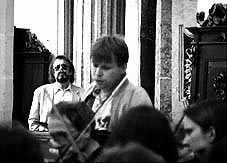Vaclav VACULOVIC, director of "Forfest '96", an international festival of contemporary arts in the Czech Republic, invited Lentz to perform "Apologetica" for the opening of the festival in June. Lentz and keyboardist/recording engineer, Brad ELLIS had already recorded the keyboards on a Synclavier system at Meta Music Studios in Los Angeles. Both acoustic and digital percussion were recorded there, as well. Lentz sent copies of the score to members of a string orchestra, The Bishop's Ensemble in the Czech Republic, which their conductor, Zdenka VACULOVICOVA, studied in the months prior to the concert. In the days preceding the performance the Ensemble rehearsed the piece with Vaculovicova, Ellis, and Lentz and recorded the strings in a medieval cathedral in the village of Kromeriz.
The world premiere performance of "Apologetica" also took place in the cathedral and the richness of music and voices in that space moved Lentz, "I enjoyed the performance in Kromeriz although it was very raw. It was in the moment. The audience was really into it, the performers were really into it, and the space was incredible. It had its own kind of magic." Although the piece was performed with live voices in the Czech Republic the voices won't be recorded until August. "We may use members from the Phoenix Bach Choir but the choir will definitely be done here in the West," says Lentz, who will mix it with engineer Mike COLEMAN at Orangewood Studios in Arizona. Coleman has previously mixed Lentz's "wolfMASS, " "b.e. comings," and "Walk Into My Voice" with Harold BUDD. "Apologetica" will be released in late 1996 or early 1997 on New Albion Records.


